The top-selling luxury brand in the U.S. for much of the 1990s, Lincoln has fallen well behind in the past decade, and now ranks eighth. To many analysts, the reason is clear: while competitors, especially those hailing from Europe, have become increasingly sophisticated, Lincoln has had to base its models heavily on mainstream Fords. Its newest model, the 2015 MKC compact crossover, shares its underlying structure and one of its two engines with the Ford Escape. A recipe for failure?
Not necessarily. The best-selling models at Acura and Lexus are based on Hondas and Toyotas, respectively. The new Audi Q3 has a healthy helping of VW under its skin. So, before we rush to judgment on the MKC, perhaps we should see what it offers above the Ford Escape, and how well it compares to the Acura RDX.
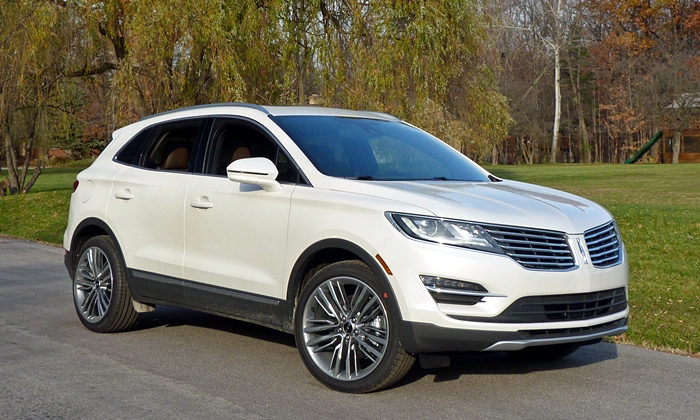
A white MKC with the optional 20-inch wheels. more MKC photos

Interior feels especially warm in hazelnut. Center stack angled upward for easy view and access.
| |
Compared to the RDX |
| Interior styling |
 Better
Worse
Better
Worse
|
Step inside the Lincoln MKC, and you'll find few clues of its Ford basis aside from the standard-issue touchscreen infotainment interface. Compared to the Escape's interior, the MKC's has cleaner, more upscale styling. Especially in white or hazelnut the atmosphere feels warmer than in a German competitor. Heavily grained, matte-finished real wood trim might polarize opinions. For those who don't like it, Lincoln offers aluminum trim as an alterative. The door panels, with quilted inserts, are far nicer than those in the Ford. The supple leather on the seat faces, sourced from Bridge of Weir in Scotland, feels richer to the hand than any other you'll find at this price point. The slicker hides in the Acura RDX and the thick skins in the Audi Q5, much less the near-vinyl in the Ford Escape, don't compare.
Not all parts of the interior are up to the standard of the door panels and seats, though. As in the Fusion-based MKZ sedan, the plastic that faces the center stack looks and feels a touch downmarket, if less so than the Acura's plentiful silver plastic. Unlike in other recently designed Lincolns, knobs are offered to adjust the volume and change stations. While good for usability, these don't look or feel as slick as the touch-sensitive sliders first seen in the 2011 MKX and now also present in the MKS, MKT, and MKZ.
These shortcomings notwithstanding, the MKC's interior is a very nice place to spend time.
| Front seat support & comfort |
 Better
Worse
Better
Worse
|
Seat comfort can be highly subjective, partly because human bodies come in many different shapes and sizes. This said, the MKC's driver seat fit me like a glove from the moment I first sat down. The seat bottom is cushier than most, including those in the Acura and Audi, while the seatback is very well contoured. You'll find more lateral support in the Acura, but the Lincoln's seats offer as much as owners are likely to need in a compact crossover.
The view forward from this seat is better than in the Ford Escape, as the MKC's windshield doesn't seem as steeply raked and doesn't have oddly curved, fishbowl-effect lower corners. Also, the top of the Lincoln's instrument panel better disguises its considerable depth. The instrument panels in the Acura and in German competitors require no such artful disguising, as they aren't nearly as deep. To the rear, the MKC's windows are at least as small as the Escape's, and smaller than the Acura's and the Audi's. Luckily the side mirrors are large and blind spot warning is an option.
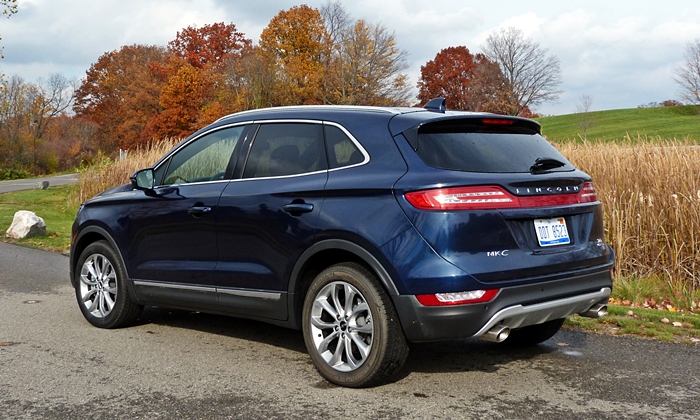
18-inch wheels don't appear under-sized.
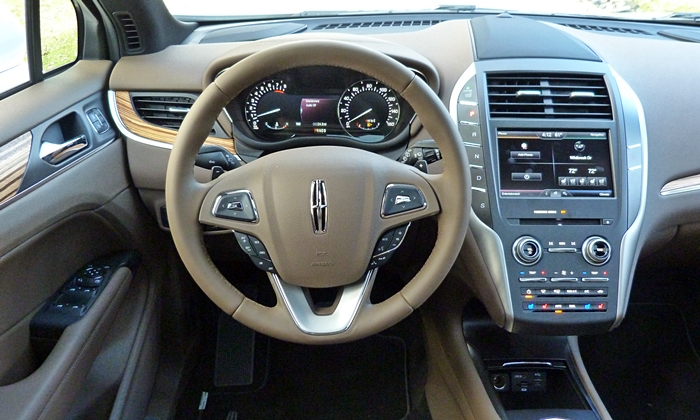
Knobs instead of the sliders found in other Lincolns.
| Ride smoothness |
 Better
Worse
Better
Worse
|
I first drove the second-generation Acura RDX a couple years ago, while evaluating the RX 350 F Sport. At the time I felt it rode and handled well, perhaps because the F Sport treatment ruined the ride quality of the Lexus without doing much for its handling.
This time around I was not impressed. Compared to the Lincoln MKC's ride, the RDX's feels insufficiently controlled, occasionally rough, and generally in need of another round or two of refinement.
The MKC has an unfair advantage, as the Ford Escape rides and handles much better than the Honda CR-V on which the RDX is based. For the MKC, Lincoln merely had to further refine an already excellent chassis. The difference isn't large, but it is noticeable. Compared to the Escape, the MKC feels even more poised and substantial, with virtually none of the bibbles, bobbles, and jiggles that afflict many crossovers. The additional substantial isn't only a matter of perception; tipping the scales at 3,791 lbs, the MKC 2.0 weighs a couple hundred more than an Escape with the same engine.
Three-mode adaptive dampers, $650 with front-wheel-drive and included with all-wheel-drive, likely deserve some of the credit. "Comfort" mode proved too floaty for my taste. The difference between "normal" and "sport" isn't large. The ride is a little more absorbant in normal, and a little more tightly controlled in sport. But it's far from harsh even in the latter.
I haven't experienced better ride quality in a compact crossover.
| Quietness |
 Better
Worse
Better
Worse
|
Similarly, the MKC is significantly quieter than the already fairly quiet Escape, and a more than a match in this regard for the RDX. Some of the Lincoln's additional 200 lbs. can be accounted for by laminated front door windows and additional sound insulation. The 2.0-liter engine sounds less sophisticated than the 2.3, but you can't hear either much. The RDX's V6 is much louder, but then it sings a song you're more likely to want to hear.
| Exterior styling |
 Better
Worse
Better
Worse
|
Outside, the Lincoln MKC also bears little resemblance to the Ford Escape. Instead, it strongly resembles the Q5, and even copies the Audi's wraparound clamsheel tailgate. Of course, if you're going to copy someone, copy the best, and the Q5 is a handsome crossover. Lincoln did add some muscle to the Audi's hyper-clean shape. Creased fender bulges are the most noticeable addition. All in all, they've dialed the Audi's shape up a notch or two, without going too far for good taste. As compact crossovers go, the MKC might not be striking, but it's certainly attractive.
| |
Compared to the RDX |
| Rear seat room & comfort |
 Better
Worse
Better
Worse
|
Unfortunately, the Lincoln MKC's key weakness is at least as apparent as any of its strengths once one moves beyond the official specs--likely cheated, per Ford's recent practice--and actually sits in its rear seat. The Escape is tighter than most back there, and the MKC is tighter still. Sitting behind my 5-9 self, my knees come within a couple inches of the front seatbacks. Put a tall driver up front, and I wouldn't fit in back. Nearly all competitors have roomier rear seats. You'll find far more shoulder room and rear knee room in the RDX.
Perhaps Lincoln should have stretched the MKC's wheelbase a few inches to expand the rear seat. As is, it's about four inches shorter than the RDX, Q5, and Volvo XC60. A roofline an inch lower than the Escape's might improve the exterior's proportions, but it cuts into interior space.
| Cargo capacity |
 Better
Worse
Better
Worse
|
Cargo capacity similarly falls short of the class average. At 53.1 cubic feet with the rear seat folded, it's four cubes short of the Q5, eight short of the RDX, and 14 short of the Volvo XC60. While cargo volume measurements are subject to gaming, subjective impressions are in line with these specs.
One bright spot: the pushbutton transmission selector and consequent absense of a shifter opens up useful storage space in the center console. Ford Escape owners, without this space, don't have a good place to stow a phone.
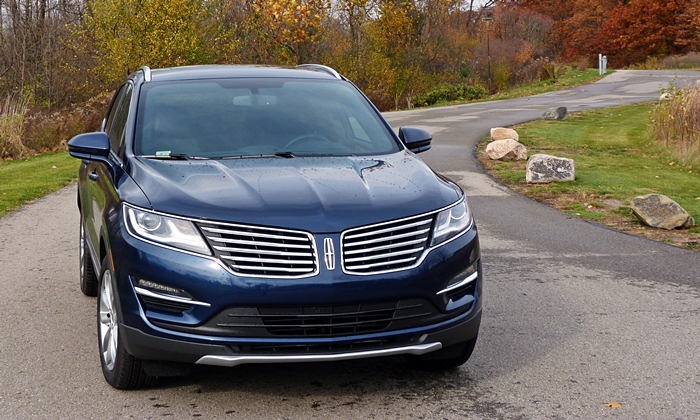
Lincoln's current face has many critics, but it works pretty well on the MKC.
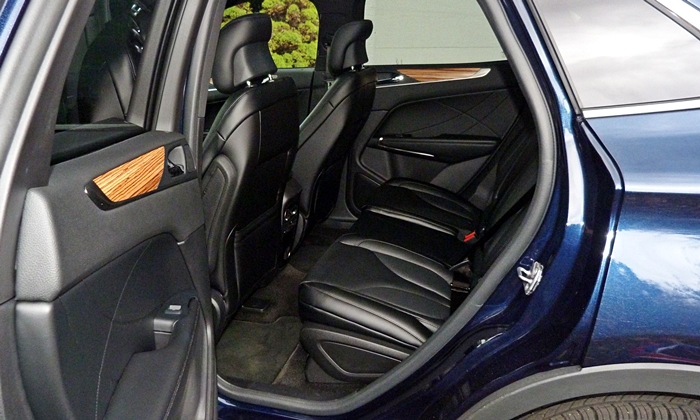
Tight back seat.
| |
Compared to the RDX |
| Powertrain performance |
 Better
Worse
Better
Worse
|
If you really want a high-performance compact crossover, there are better options, most notably the Audi SQ5 and BMW X3. Or the Porsche Macan Turbo, which easily out-scoots them all.
But for anything approaching typical driving the MKC's performance is more than sufficient even with the base engine, a 240-horsepower turbocharged 2.0-liter four-cylinder that is the Escape's strongest engine. Want a little more thrust? Then spend $1,140 for the optional engine, a 285-horsepower turbocharged 2.3-liter four, and you'll be able to get from a dead stop to 60 mph about a second sooner (roughly 6.5 vs. 7.5). With a 273-horsepower 3.5-liter V6, the Acura RDX is a little quicker than an MKC with the 2.3.
Both engines are paired with a paddle-shiftable six-speed automatic transmission. With front-wheel-drive, the MKC's steering wheels squirms just a bit with hard acceleration. Overall, the 2.0-liter's torque is managed well enough that all-wheel-drive isn't a must for performance purposes. The torquier 2.3-liter is offered only with all-wheel-drive.
| Fuel economy |
 Better
Worse
Better
Worse
|
Unfortunately, the Lincoln MKC's relatively compact size doesn't render it more fuel efficient. The base powertrain's EPA ratings, 20 mpg city and 29 mpg highway, barely top the larger, V6-powered RDX's 20/28. AWD drops the figures all the way to 19/26, while the 2.3-liter engine knicks another mpg off the city rating. The all-wheel-drive RDX, not known for fuel efficiency itself, slightly bests the MKC 2.3's ratings, 19/27 vs. 18/26. The Audi Q5, with standard AWD, tops both with 20/28, but is also less powerful (220). The Volvo with front-wheel-drive is easily the best of the bunch, with 24/31. But you can't get Volvo's new engines with all-wheel-drive yet. So add this and the XC60's EPA ratings plummet to 18/25.
The four-cylinder diesel engines offered by BMW (27/34) and Mercedes-Benz (24/33) and the hybrid version of the new Lexus NX (35/31 with FWD, 33/30 with AWD) are the fuel economy champs of the class. Lincoln should consider countering them with the hybrid powertrain from the MKZ sedan.
In my real-world suburban driving, 29.5 mpg was the best average I managed to squeeze from the MKC's trip computer. Mid-20s were far more common. With a cold start and Gayla's heavier foot in moderate traffic, it reported 19.8 mpg. On a 70-mph highway it reported a two-way average around 30 mpg, just barely above the EPA rating.
| Handling |
 Better
Worse
Better
Worse
|
When the road curves, the Lincoln MKC again benefits from its Escape underpinnings. Lean in turns is moderate and the electronic chassis controls limit understeer and boost agility. Push the MKC hard, and the chassis maintains its composure. Moderately firm, well-weighted steering inspires far more confidence than the far too light wheel in the RDX. If memory serves, I was also less impressed by the relatively lifeless steering in both the Audi Q5 and the Volvo XC60. Though the Lincoln certainly isn't a hardcore sports machine, I enjoyed driving it much more than I expected to.
| Controls and instruments |
 Better
Worse
Better
Worse
|
While the MyFord Touch (here MyLincoln Touch) interface continues to include too many overly small virtual buttons that are not far enough apart--or far enough from the edge--the touchscreen is at least large and close at hand in the MKC. The entire center stack is set at an angle, making everything easier to reach than in crossovers with vertical center stacks, most notably the Audi Q5. The push-button transmission selector takes a little getting used to, and provides no more of a driving experience benefit here than it does in the MKZ sedan. Maybe if the buttons had more weight to them. The layout does place the [S]port button where it can be seen and tapped at a glance, for easy switching between driving modes. And, as noted earlier, it opens up a useful space for storing your personal electronics.
| Price or payments |
 Better
Worse
Better
Worse
|
The Lincoln MKC starts at $33,995. Add $3,230 for the Select Package, which includes the soft leather, additional power adjustments for the front passenger seat, and a few other less significant features. (TrueDelta's defaults put the total value of these features around $1,700, but we don't ascribe any more value to premium leather than to economy grade hides.) Add another $1,100 for the Select Plus Package to get a navigation and a blind spot warning system. A similarly equipped Ford Escape Titanium lists for $4,925 less and includes about $1,100 in additional features. These additional features can only be added to the MKC by purchasing the pricey Reserve and Technology Packages. Figure that the upgraded interior and smoother, quieter ride of the MKC cost $5-6k. Worth it? This will depend on how much you personally value them.
Want a panoramic sunroof? One is $1,495 on the Ford but $1,700 on the Lincoln. Similarly, all-wheel-drive is $1,750 on the Ford but $2,495 on the Lincoln, partly because it includes adaptive dampers (which otherwise cost $650). Tick every single box on the Lincoln, including special paint, and its sticker will barely top $50,000.
The tested MKC, with front-wheel-drive, the Select and Select Plus Packages, the sunroof, and adaptive dampers, listed for $40,675. An Acura RDX with Technology Package lists for $1,185 less, but comes up about $2,000 short in the features department. Note, though, that the RDX includes a stronger engine and more powerful audio system. Add the larger engine and 700-watt THX audio to the Lincoln, and add all-wheel-drive to the Acura to keep things even, and the MKC checks in $3,765 higher, $44,655 vs. $40,890. About $2,300 of the difference can be attributed to the Lincoln's additional features, leaving about $1,500. Is the Lincoln $1,500 better, despite being more cramped inside? I'd say so.
And the European competition? The Lincoln MKC undercuts the Audi Q5 and the Volvo XC60 by about $4,000 and about $3,000, respectively. This seems about right, given their slightly roomier rear seats and more prestigious badges.
Seen against Lincoln's best days, when its cars rivaled the best in the world, a Ford Escape-based crossover might seem unworthy of the brand. But evaluated on its own merits, the new MKC impresses. It rides and handles well, has a well-finished interior with a warm ambiance and comfortable front seats, and looks the part. Given how people typically drive upscale crossovers, it ranks among the best--as long as an adult-friendly back seat isn't a priority. If one is, wait for the redesigned 2016 MKX.
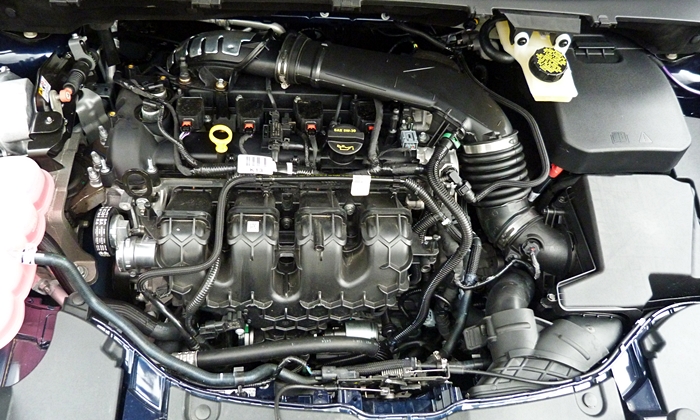
Beyond adequate performance even from the base engine.
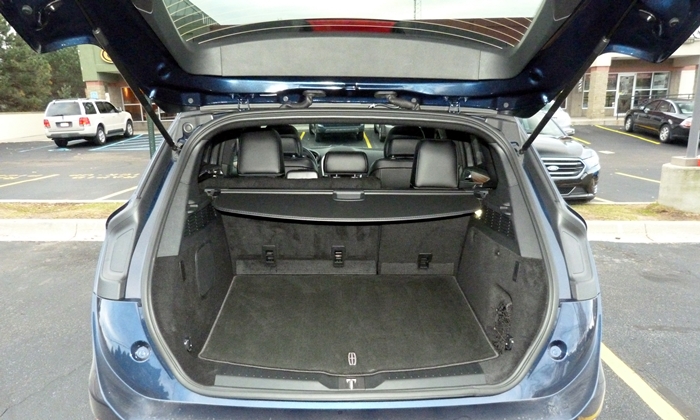
Large tailgate opens up to compact cargo area.
See more 2015 Lincoln MKC photos
Lincoln provided a fueled, insured MKC for a week. Richard Wolf (248-354-4900) of Star Lincoln in Southfield, MI, provided one with the 2.3. Ramzy Sheikh (248-427-5734) of Suburban Acura in Farmington Hills, MI, provided an RDX for comparison purposes.











